Lack of Syllable Duration as a Post-Lexical Acoustic Cue in Spanish in Contact with Maya
Abstract
:1. Introduction
- El gato de botas [CFOC ROJAS] se comió un ratón y no el de botas [CFOC AZULES].“The cat with red boots ate a mouse, not the one with blue boots.” (Zubizarreta 1999, p. 4230)
- ¿Qué pasa?—[BFOC Juan está comiendo un helado].“What’s happening?—John is eating ice cream.”
[…] lo primero que llama la atención del forastero […] es la entonación fraseal, lenta y pausada, fenómenos que no son sino reflejos de la fonética nativa [maya]. ‘[…] the first thing that attracts the attention of the foreigner […] is the unhurried and deliberate pronunciation, which is nothing else than the mirror image of the native [Mayan] phonetics.’
- 3.
- Tumen to’on-e’ [FOC maaya] k t’an-ik-øbecause 1.PL-TOP Maya HAB.ERG.1PL speak-IND-ABS.3SG“Porque nosotros lo que hablamos es MAYA.” [“Because what we speak is MAYA”](Gutiérrez Bravo 2015, p. 21; our English translation)
- 4.
- Ellos, VENIR hicieron acá en Yucatánthey come-INF do.PAST.3PL here in Yucatán“They, they came here to Yucatán.” (Gutiérrez-Bravo et al. 2019, p. 279)
2. Materials and Methods
2.1. Participants
2.2. Experimental Design
2.3. Data Analysis
3. Results
3.1. Results for Subject Position
3.2. Results for Object Position
3.3. Summary of Results
4. Discussion
5. Conclusions
Author Contributions
Funding
Acknowledgments
Conflicts of Interest
Appendix A
| Number of Observations | |||||||
|---|---|---|---|---|---|---|---|
| Subject | Object | ||||||
| Participant ID | BLP Score | Gender | Age | Broad Focus | Contrastive Focus | Broad Focus | Contrastive Focus |
| 01 | 95.994 | male | 22 | 17 | 10 | 4 | 4 |
| 02 | 153.742 | male | 18 | 16 | 10 | 4 | 4 |
| 03 | 129.86 | female | 20 | 17 | 10 | 4 | 4 |
| 04 | 65.754 | female | 31 | 17 | 10 | 4 | 4 |
| 05 | 101.618 | male | 21 | 18 | 9 | 4 | 4 |
| 06 | 37.146 | female | 84 | 16 | 9 | 4 | 4 |
| 07 | 202.05 | female | 54 | 17 | 9 | 4 | 4 |
| 08 | 96.444 | male | 72 | 13 | 10 | 3 | 4 |
| 10 | 158.92 | male | 38 | 16 | 10 | 4 | 4 |
| 11 | 195.24 | female | 67 | 16 | 10 | 2 | 2 |
| 12 | 178.896 | male | 34 | 14 | 2 | 4 | 4 |
| 13 | 177.08 | female | 36 | 17 | 9 | 4 | 4 |
| 14 | 9.992 | male | 46 | 16 | 9 | 3 | 3 |
| 15 | −26.246 | female | 43 | 16 | 9 | 4 | 4 |
| 17 | −45.952 | female | 30 | 16 | 10 | 4 | 4 |
| 18 | −23.702 | female | 38 | 17 | 10 | 4 | 4 |
| 19 | −24.426 | female | 34 | 17 | 6 | 4 | 4 |
| 20 | −20.434 | male | 47 | 15 | 9 | 4 | 3 |
| 22 | −25.146 | male | 38 | 17 | 7 | 4 | 4 |
| 23 | 99.172 | female | 37 | 16 | 10 | 4 | 4 |
| 24 | 141.668 | male | 47 | 16 | 7 | 3 | 3 |
| 25 | 35.334 | female | 44 | 17 | 9 | 4 | 4 |
| 26 | 56.764 | female | 41 | 17 | 10 | 4 | 4 |
| 27 | 22.798 | female | 58 | 17 | 10 | 4 | 4 |
| 28 | 177.08 | female | 63 | 17 | 10 | 4 | 4 |
| 29 | 159.828 | male | 66 | 15 | 10 | 4 | 4 |
| 30 | 157.104 | male | 46 | 17 | 10 | 4 | 4 |
| 31 | 179.804 | female | 34 | 17 | 10 | 4 | 4 |
| 32 | 49.858 | male | 33 | 16 | 9 | 4 | 4 |
| 36 | 69.658 | female | 26 | 17 | 6 | 4 | 4 |
| 38 | 89.906 | male | 17 | 17 | 10 | 4 | 4 |
| 39 | 4.99 | male | 20 | 15 | 10 | 4 | 4 |
| 40 | −9.984 | male | 18 | 17 | 10 | 4 | 4 |
| 41 | 45.228 | female | 43 | 17 | 9 | 4 | 4 |
References
- Baird, Brandon O. 2014. Acoustic Correlates of Stress in K’ichee’: A Preliminary Investigation. MIT Working Papers in Linguistics 74: 21–34. [Google Scholar]
- Baird, Brandon O. 2017. Prosodic Transfer among Spanish-K’ichee’ Bilinguals. In Multidisciplinary Approaches to Bilingualism in the Hispanic and Lusophone World. Edited by Kate Bellamy, Michael W. Child, Paz González, Antje Muntendam and M. Carmen Parafita Couto. Issues in Hispanic and Lusophone Linguistic 13. Amsterdam and Philadelphia: John Benjamins, pp. 149–74. [Google Scholar] [CrossRef]
- Barnes, Hilary, and Jim Michnowicz. 2013. Peak Alignment in Semispontaneous Bilingual Chipilo Spanish. In Selected Proceedings of the 6th Workshop on Spanish. Edited by Ana M. Carvalho and Sara Beaudrie. Somerville: Cascadilla Proceedings Project, pp. 109–22. [Google Scholar]
- Barrera Vásquez, Alfredo. 1977. El idioma español en Yucatán. In Enciclopedia Yucatanense 6. Yucatán Actual, 2nd ed. Edited by Luis H. Hoyos Villanueva, Renan Irigoyen Rosado, Rodolfo Ruz Menéndez and Humberto Lara y Lara. Ciudad de México: Gobierno de Yucatán, pp. 341–75. [Google Scholar]
- Bates, Douglas, Martin Maechler, Ben Bolker, and Steve Walker. 2015. Fitting Linear Mixed-Effects Models Using Lme4. Journal of Statistical Software 67: 1–48. [Google Scholar] [CrossRef]
- Birdsong, David, Libby M. Gertken, and Marc Amengual. 2012. Bilingual Language Profile: An Easy-to-Use Instrument to Assess Bilingualism. Austin: COERLL, University of Texas at Austin, Available online: https://sites.la.utexas.edu/bilingual/ (accessed on 19 December 2017).
- Bisang, Walter. 2006. Linguistic Areas, Language Contact and Typology: Some Implications from the Case of Ethiopia as a Linguistic Area. In Linguistic Areas: Convergence in Historical and Typological Perspective. Edited by Yaron Matras, April McMahon and Nigel Vincent. London: Palgrave Macmillan UK, pp. 75–98. [Google Scholar] [CrossRef]
- Boersma, Paul, and David Weenink. 2009. Praat: Doing Phonetics by Computer (Version 6.0.43): [Computer Program]. Available online: http://www.praat.org/ (accessed on 10 December 2018).
- Bracamonte y Sosa, Pedro. 1986. La montaña y la resistencia de los mayas yucatecos frente al colonialismo español. In Quintana Roo: Procesos Políticos y Democracia. Edited by Maria Cristina Castro, Gabriel Macías, Antonio Higuera and Luz del Carmen Vallarta. México: Centro de Investigaciones y Estudios Superiores en Antropología Social, pp. 39–63. [Google Scholar]
- Breen, Mara, Evelina Fedorenko, Michael Wagner, and Edward Gibson. 2010. Acoustic Correlates of Information Structure. Language and Cognitive Processes 25: 1044–98. [Google Scholar] [CrossRef]
- Büring, Daniel. 2009. Towards a Typology of Focus Realization. In Information Structure. Edited by Malte Zimmermann and Caroline Féry. Oxford: Oxford University Press, pp. 177–205. [Google Scholar]
- Campbell, Lyle. 2006. Areal Linguistics: A Closer Scrutiny. In Linguistic Areas: Convergence in Historical and Typological Perspective. Edited by Yaron Matras, April McMahon and Nigel Vincent. London: Palgrave Macmillan UK, pp. 1–31. [Google Scholar] [CrossRef]
- Van Coetsem, Frans. 1988. Loan Phonology and the Two Transfer Types in Language Contact. Dordrecht: Foris. [Google Scholar] [CrossRef]
- Cruschina, Silvio. 2012. Discourse-Related Features and Functional Projections. Oxford Studies in Comparative Syntax. Oxford: Oxford University Press. [Google Scholar] [CrossRef]
- Domínguez, Laura. 2004. Mapping Focus: The Syntax and Prosody of Focus in Spanish. Boston: Boston University. [Google Scholar]
- Eiss, Paul K. 2004. Deconstructing Indians, Reconstructing Patria: Indigenous Education in Yucatan from the Porfiriato to the Mexican Revolution. Journal of Latin American Anthropology 9: 119–50. [Google Scholar] [CrossRef]
- England, Nora C., and Brandon O. Baird. 2017. Phonology and Phonetics. In The Mayan Languages. Edited by Judith Aissen, Nora C. England and Roberto Zavala Maldonado. Routledge Language Family Series; New York: Routledge, pp. 175–200. [Google Scholar]
- Face, Timothy L. 2000. Prosodic Manifestations of Focus in Spanish. Southwest Journal of Linguistics 19: 45–62. [Google Scholar]
- Face, Timothy L. 2002. Intonational Marking of Contrastive Focus in Madrid Spanish. Muenchen: LINCOM Europa. [Google Scholar]
- Fallaw, Ben. 2004. Rethinking Mayan Resistance: Changing Relations between Federal Teachers and Mayan Communities in Eastern Yucatan, 1929–1935. Journal of Latin American Anthropology 9: 151–78. [Google Scholar] [CrossRef]
- Frazier, Melissa. 2009. The Production and Perception of Pitch and Glottalization in Yucatec Maya. Ph.D. thesis, University of North Carolina, Chapel Hill, NC, USA. [Google Scholar]
- García Fajardo, Josefina. 1984. Fonética Del Español de Valladolid, Yucatán. México City: Universidad Nacional Autónoma de México, Instituto de Investigaciones Filológicas. [Google Scholar]
- García-Lecumberri, María Luisa. 1995. Intonational Signalling of Information Structure in English and Spanish: A Comparative Study. London: University of London, Available online: http://hdl.handle.net/10068/448827 (accessed on 1 September 2018).
- Gobierno del Estado de Quintana Roo-Secretaría de Desarrollo Social. 2010. Preservación de la Cultura y la Lengua Maya. Available online: http://www.coneval.org.mx/sitios/RIEF/Documents/Quintanaroo-diagnostico-lengua-cultura-maya-2010.pdf (accessed on 20 December 2017).
- Grube, Nikolai. 2000. Maya heute—Vom entrechteten Indio zum Indianischen Aufbruch. In Maya: Gottkönige im Regenwald. Edited by Nikolai Grube. Köln: Könemann, pp. 416–26. [Google Scholar]
- Gussenhoven, Carlos. 2007. Types of Focus in English. In Topic and Focus. Studies in Edited by Chungmin Lee, Matthew Gordon and Daniel Büring. Linguistics and Philosophy 82. Dordrecht: Springer, pp. 83–100. [Google Scholar] [CrossRef]
- Gussenhoven, Carlos, and Renske Teeuw. 2008. A Moraic and a Syllabic H-Tone in Yucatec Maya. In Fonología Instrumental: Patrones Fónicos y Variación. Edited by Esther Z. Herrera and Pedro Martín Butragueño. México: El Colegio de México, pp. 49–71. [Google Scholar]
- Gutiérrez Bravo, Rodrigo. 2008. La Identificación de Los Tópicos y Los Focos. Nueva Revista de Filología Hispánica 56: 363–401. Available online: https://www.doi.org/10.24201/nrfh.v56i2.969 (accessed on 10 October 2017).
- Gutiérrez Bravo, Rodrigo. 2015. El Foco de Verbo En Maya Yucateco. In Nuevos Estudios de Teoría de La Optimidad. Sintaxis, Estudios Fónicos y Lingüística Computacional. Edited by Rodrigo Gutiérrez Bravo, Francisco Arellanes Arellanes and Mario Ernesto Chávez Peón Herrero. México: El Colegio de México, pp. 17–48. [Google Scholar]
- Gutiérrez-Bravo, Rodrigo, Carlos Martín Sobrino, and Melanie Uth. 2019. Contrastive Focus in Yucatecan Spanish. In The Syntactic Variation of Spanish Dialects. Edited by Ángel J. Gallego. Oxford Studies in Comparative Syntax. Oxford: Oxford University Press, pp. 275–96. [Google Scholar]
- Halliday, Michael A. K. 1967. Notes on Transitivity and Theme in English: Part 2. Journal of Linguistics 3: 199–244. [Google Scholar] [CrossRef]
- Hickey, Raymond. 2017. The Cambridge Handbook of Areal Linguistics. Cambridge: Cambridge University Press. [Google Scholar] [CrossRef]
- Higuera Bonfil, Antonio. 1986. La penetración protestante en la zona maya de Quintana Roo. In Quintana Roo: Procesos Políticos y Democracia. Edited by Ma. Cristina Castro, Gabriel Macías, Antonio Higuera and Luz del Carmen Vallarta. México: Centro de Investigaciones y Estudios Superiores en Antropología Social, pp. 51–66. [Google Scholar]
- Hirst, Daniel. 2009. Analyse Tier.Praat (Version 2009-08-07). Available online: http://uk.groups.yahoo.com/group/praat-users/files/Daniel_Hirst/analyse_tier.praat (accessed on 1 February 2011).
- Hostettler, Ueli. 1999. ‘Supimos ayudar en algo al progreso del pueblo’: Maestros y escuelas rurales en comunidades del centro de Quintana Roo, México. In Interculturalidad e Identidad Indígena: Preguntas Abiertas a la Globalización en México. Edited by Barbara Pfeiler. Hannover: Verlag für Ethnologie, pp. 237–70. [Google Scholar]
- Hualde, José Ignacio. 2009. Unstressed Words in Spanish. Language Sciences 31: 199–212. [Google Scholar] [CrossRef]
- Instituto Nacional de Estadística y Geografía-INEGI. 2015. Encuesta Intercensal (2015). Panorama Sociodemográfico de México. Available online: http://seieg.iplaneg.net/seieg/doc/Panorama_Sociodemografico_2015_1452886126.pdf (accessed on 13 July 2019).
- Instituto Nacional de Lenguas Indígenas-INALI. 2010. Población de 5 años y más Hablante de Alguna Lengua Indígena por Familia y Agrupación Lingüística para los Años 2000, 2005 y 2010. Available online: https://www.inali.gob.mx/es/transparencia/datos-abiertos.html (accessed on 13 July 2019).
- Joseph, Gilbert M. 2003. Revolution from without. Yucatán, Mexico, and the United States, 1880–1924, 3rd ed. Duke University: Durham. [Google Scholar]
- Kim, Sahyang, and Heriberto Avelino. 2003. An Intonational Study of Focus and Word Order Variation in Mexican Spanish. In La Tonía: Dimensiones Fonéticas y Fonológicas. Edited by Herrera Z. Esther and Pedro Martín Butragueño. Estudios de Lingüística 4. México: El Colegio de México, pp. 357–74. [Google Scholar]
- Kisler, Thomas, Uwe Reichel, and Florian Schiel. 2017. Multilingual Processing of Speech via Web Services. Computer Speech & Language 45: 326–47. [Google Scholar] [CrossRef]
- Kügler, Frank, and Stavros Skopeteas. 2007. On the Universality of Prosodic Reflexes of Contrast: The Case of Yucatec Maya. Paper presented at 16th International Congress of Phonetic Sciences, Saarbrücken, Germany, August 6–10; pp. 1025–28. Available online: https://pub.uni-bielefeld.de//luur/download?func=downloadFile&recordOId=2143409&fileOId=2276179 (accessed on 10 October 2017).
- Kügler, Frank, Stavros Skopeteas, and Elisabeth Verhoeven. 2007. Encoding Information Structure in Yucatec Maya: On the Interplay of Prosody and Syntax. Interdisciplinary Studies on Information Structure 8: 187–208. [Google Scholar]
- Lehmann, Christian. 1990. Yukatekisch. Zeitschrift für Sprachwissenschaft 9: 28–51. [Google Scholar] [CrossRef]
- Lipski, John M. 2004. A History of Afro-Hispanic Language: Five Centuries, Five Continents. New York: Cambridge Univ. [Google Scholar]
- Llisterri, Joaquim, María J. Machuca, Antonio Ríos, and Sandra Schwab. 2016. La percepción del acento léxico en un contexto oracional. Loquens 3: e033. [Google Scholar] [CrossRef]
- Lope Blanch, Juan M. 1987. Estudios Sobre el español de Yucatán. México: Universidad Nacional Autónoma de México. [Google Scholar]
- López, Luis. 2009. A Derivational Syntax for Information Structure. Oxford: Oxford University Press. [Google Scholar] [CrossRef]
- Martínez Huchim, Ana Patricia. 2004. Diccionario Maya: Español-Maya, Maya-Español, 2nd ed.Mérida: Dante. [Google Scholar]
- Mediz Bolio, Antonio. 1951. Interinfluencia del Maya con el Español de Yucatán. Mérida: Zamná. [Google Scholar]
- Michnowicz, James Casimir. 2006. Linguistic and Social Variables in Yucatan Spanish. Ph.D. thesis, Pennsylvania State University, State College, PA, USA. Available online: https://etda.libraries.psu.edu/files/final_submissions/2585 (accessed on 10 October 2017).
- Michnowicz, Jim. 2006. Final -m in Yucatan Spanish. A Rapid and Anonymous Survey. In New Perspectives on Romance Linguistics: Vol. II: Phonetics, Phonology and Dialectology. Selected Papers from the 35th Linguistic Symposium on Romance Languages (LSRL), Austin, Texas, February 2005. Edited by Jean-Pierre Y. Montreuil. Current Issues in Linguistic Theory 276. Amsterdam: John Benjamins. [Google Scholar] [CrossRef]
- Michnowicz, Jim. 2007. El Habla de Yucatám: Final [m] in a Dialect in Contact. In Selected Proceedings of the Third Workshop on Spanish Sociolinguistics. Edited by Jonathan Holmquist, Augusto Lorenzino and Lotfi Sayahi. Somerville: Cascadilla Proceedings Project, pp. 38–43. Available online: http://www.lingref.com/cpp/wss/3/paper1524.pdf (accessed on 9 July 2019).
- Michnowicz, Jim. 2008. Final Nasal Variation in Merida, Yucatan. Spanish in Context 5: 278–303. [Google Scholar] [CrossRef]
- Michnowicz, Jim. 2015. Maya-Spanish Contact in Yucatan, Mexico: Context and Sociolinguistic Implications. In New Perspectives on Hispanic Contact Linguistics in the Americas. Edited by Sandro Sessarego and Melvin González-Rivera. Madrid: Iberoamericana/Vervuert, pp. 21–42. [Google Scholar]
- Michnowicz, Jim, and Hilary Barnes. 2013. A Sociolinguistic Analysis of Pre-Nuclear Peak Alignment in Yucatan Spanish. In Selected Proceedings of the 15th Hispanic Linguistics Symposium. Edited by Chad Howe, Sarah E. Blackwell and Margaret Lubbers Quesada. Somerville: Cascadilla Proceedings Project, pp. 221–35. [Google Scholar]
- Michnowicz, Jim, and Lindsey Carpenter. 2013. Voiceless Stop Aspiration in Yucatan Spanish: A Sociolinguistic Analysis. Spanish in Context 10: 410–37. [Google Scholar] [CrossRef]
- Michnowicz, Jim, and Laura Kagan. 2016. On Glottal Stops in Yucatan Spanish. In Spanish Language and Sociolinguistic Analysis. Edited by Sandro Sessarego and Fernando Tejedo-Herrero. Issues in Hispanic and Lusophone Linguistic 8. Amsterdam and Philadelphia: John Benjamins, pp. 217–40. [Google Scholar] [CrossRef]
- De-la-Mota, Carme, Pedro Martín Butragueño, and Pilar Prieto. 2010. Mexican Spanish Intonation. In Transcription of Intonation of the Spanish Language. Edited by Pilar Prieto and Paolo Roseano. München: Lincom Europa, pp. 319–50. [Google Scholar]
- De la Mota Gorriz, Carme. 1995. La Representación Gramatical de la información Nueva en el Discurso; Bellaterra: Universitat Autònoma de Barcelona. Available online: http://hdl.handle.net/10803/4883 (accessed on 18 August 2019).
- De la Mota Gorriz, Carme. 1997. Prosody of Sentences with Contrastive New Information in Spanish. In Intonation: Theory, Models, and Applications. Athens: European Speech Communication Association, pp. 75–78. [Google Scholar]
- Muntendam, Antje, and Francisco Torreira. 2016. Focus and Prosody in Spanish and Quechua: Insights from an Interactive Task. In Intonational Grammar in Ibero-Romance: Approaches across Linguistic Subfields. Edited by Meghan E. Armstrong, Nicholas Henriksen and Maria del Mar Vanrell. Issues in Hispanic and Lusophone Linguistics 6. Amsterdam and Philadelphia: John Benjamins, pp. 69–90. [Google Scholar] [CrossRef]
- Pfeiler Blaha, Barbara. 1992. Así som, los de Yucatam: El proceso fonológico Vn -> m/__ (#, C) en dos lenguas en contacto. In Memorias Del Primer Congreso Internacional de Mayistas. México: Universidad Nacional Autónoma de México, pp. 110–22. [Google Scholar]
- Pike, Kenneth L. 1946. Phonemic Pitch in Maya. International Journal of American Linguistics 12: 82. [Google Scholar] [CrossRef]
- Quilis, Antonio. 1999. Tratado de Fonología y Fonética Españolas, 2nd ed. Madrid: Gredos. [Google Scholar]
- R Core Team. 2018. Vienna: R Foundation for Statistical Computing. Available online: https://www.r-project.org/ (accessed on 19 December 2017).
- Reed, Nelson. 1968. The Caste War of Yucatán. Stanford: Stanford University Press. [Google Scholar]
- Sainz-Maza Lecanda, Lorena. 2017. Interactions among Focus, Exhaustivity, and Constituent Order in Spanish and Basque; Columbus: Ohio State University. Available online: https://etd.ohiolink.edu/ (accessed on 18 August 2019).
- Scheuzger, Stephan. 2009. Der Andere in der Ideologischen Vorstellungskraft: Die Linke und die Indigene Frage in Mexiko. Editionen der Iberoamericana. Serie C: Geschichte und Gesellschaft 12. Frankfurt am Main: Vervuert. [Google Scholar]
- Smiljanić, Rajka. 2004. Lexical, Pragmatic, and Positional Effects on Prosody in Two Dialects of Croatian and Serbian. An Acoustic Study. New York: Routledge. [Google Scholar]
- Sobrino, Carlos Martín. 2010. Contacto lingüístico maya-español: Transferencias en la morfosintaxis del español yucateco. Temas Antropológicos 32: 79–94. [Google Scholar]
- Stevens, Jon Scott. 2017. Pragmatics of Focus. Oxford: Oxford University Press. [Google Scholar] [CrossRef]
- Suárez Molina, Víctor M. 1996. El Español que se Habla en Yucatán: Apuntamientos Filológicos, 3rd ed. Revised and Corrected by Miguel Güémez Pineda. Mérida: Universidad Autónoma de Yucatán. [Google Scholar]
- Thomason, Sarah G. 2001. Language Contact. An Introduction. Edinburgh: Edinburgh University Press. [Google Scholar]
- Van Rijswijk, Remy, Antje Muntendam, and Ton Dijkstra. 2017. Focus Marking in Dutch by Heritage Speakers of Turkish and Dutch L1 Speakers. Journal of Phonetics 61: 48–70. [Google Scholar] [CrossRef]
- Winford, Donald. 2014. In Search of a Unified Model of Language Contact. Bilingualism: Language and Cognition 16: 734–36. [Google Scholar] [CrossRef]
- Yager, Kent. 1989. La-m bilabial en posición final absoluta en el español hablado En Mérida, Yucatán (México). Nueva Revista de Filología Hispánica 27: 83–94. [Google Scholar] [CrossRef]
- Zagona, Karen T. 2002. The Syntax of Spanish. Cambridge: Cambridge University Press. [Google Scholar]
- Zimmermann, Malte, and Edgar Onea. 2011. Focus Marking and Focus Interpretation. Focus Marking Strategies and Focus Interpretation 121: 1651–70. [Google Scholar] [CrossRef]
- Zubizarreta, María Luisa. 1998. Prosody, Focus, and Word Order. Cambridge: The MIT Press. [Google Scholar]
- Zubizarreta, María Luisa. 1999. Las Funciones informativas: Tema y foco. In Gramática Descriptiva de la Lengua Española, Volume 3. Edited by Ignacio Bosque and Violeta Demonte. Madrid: Espasa Calpe, pp. 4215–44. [Google Scholar]
| 1 | We thank a reviewer for this useful piece of information. |
| 2 | Secondly, we might draw our attention to other contact varieties of Spanish, since it has been found that Peruvian Spanish does not seem to have post-lexical duration either (Muntendam and Torreira 2016). However, this issue is beyond the scope of the present paper so we have decided to tackle it in future research. |
| 3 | The war was declared officially over in 1915, but it is generally considered to have ended already when the military governor Francisco Bravo and his troops occupied Chan Santa Cruz (i.e., the present city of Felipe Carrillo Puerto) in 1901. |

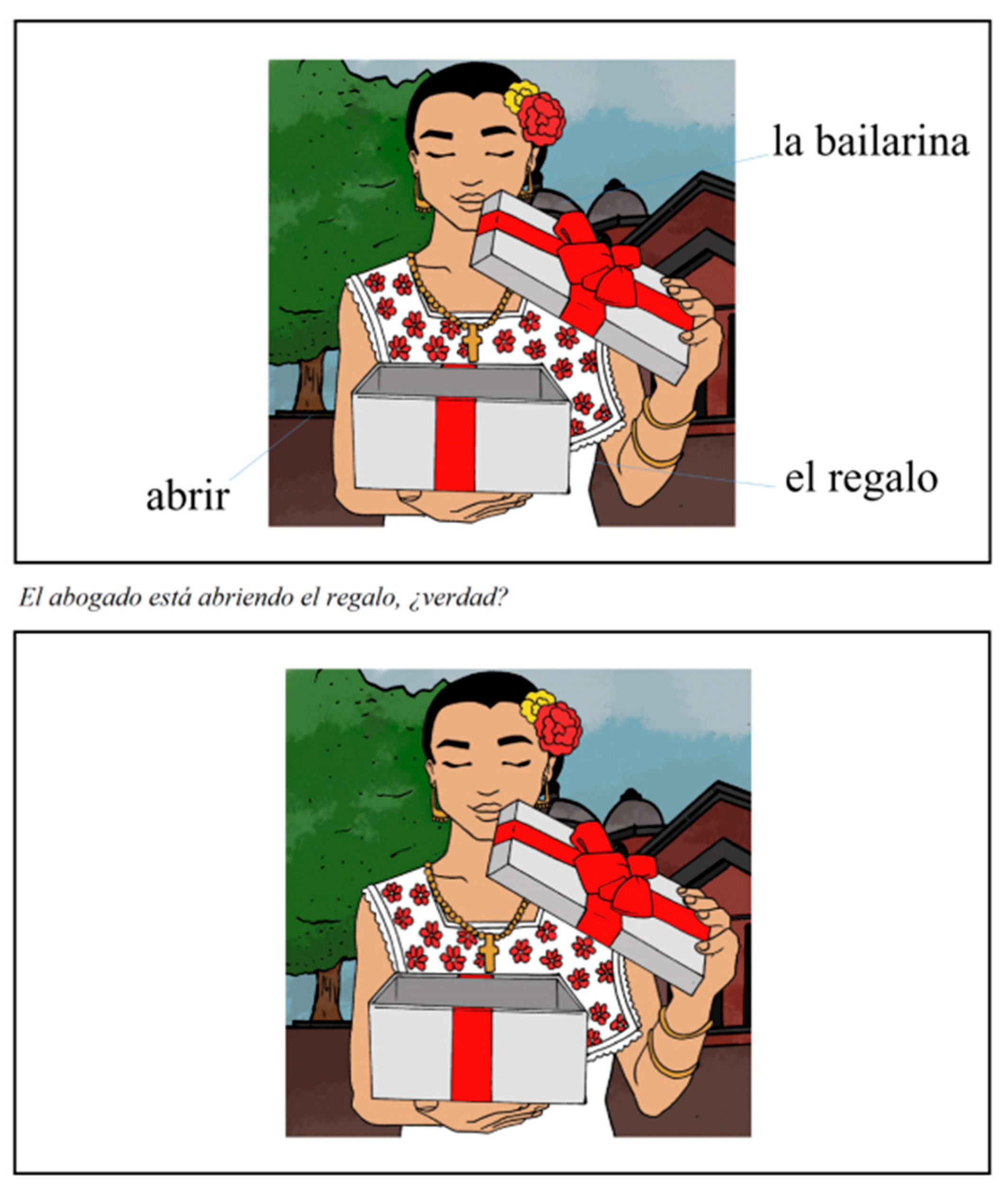
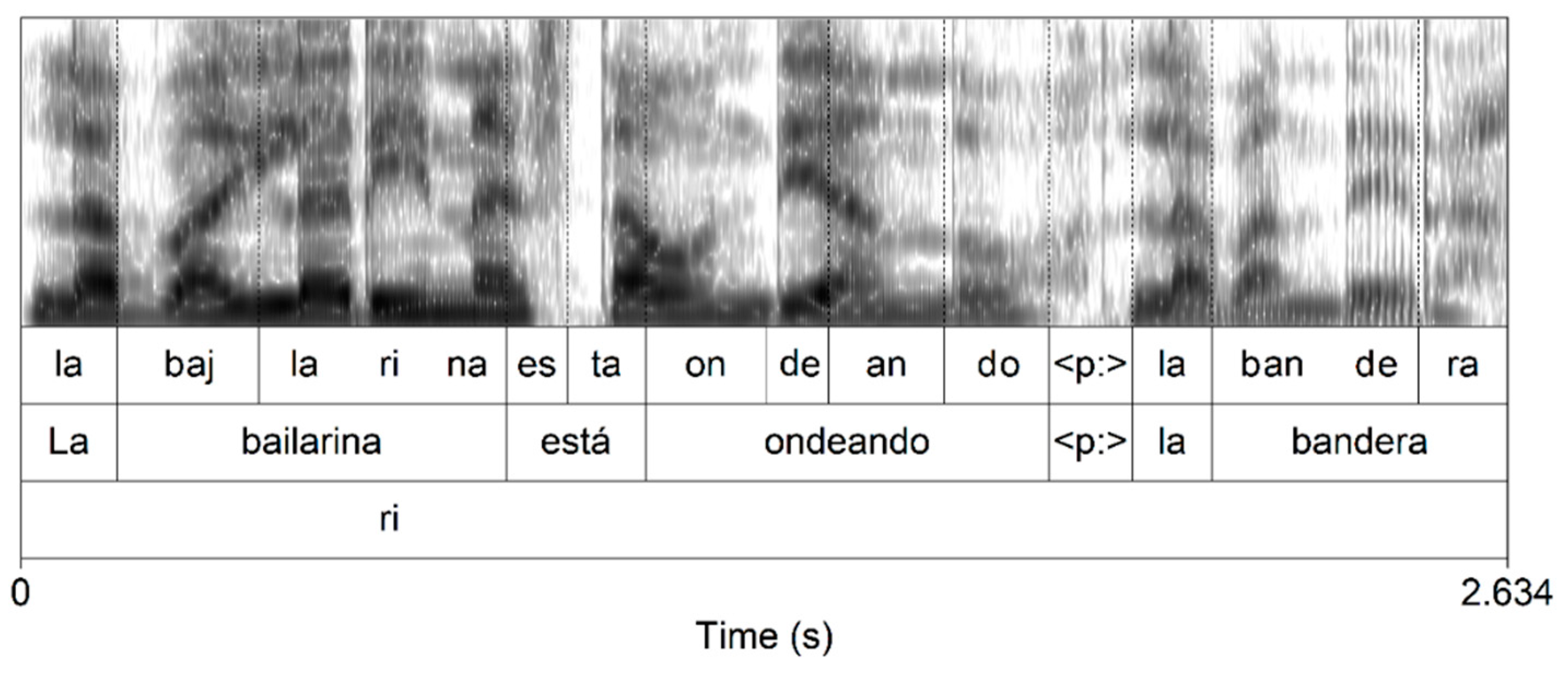
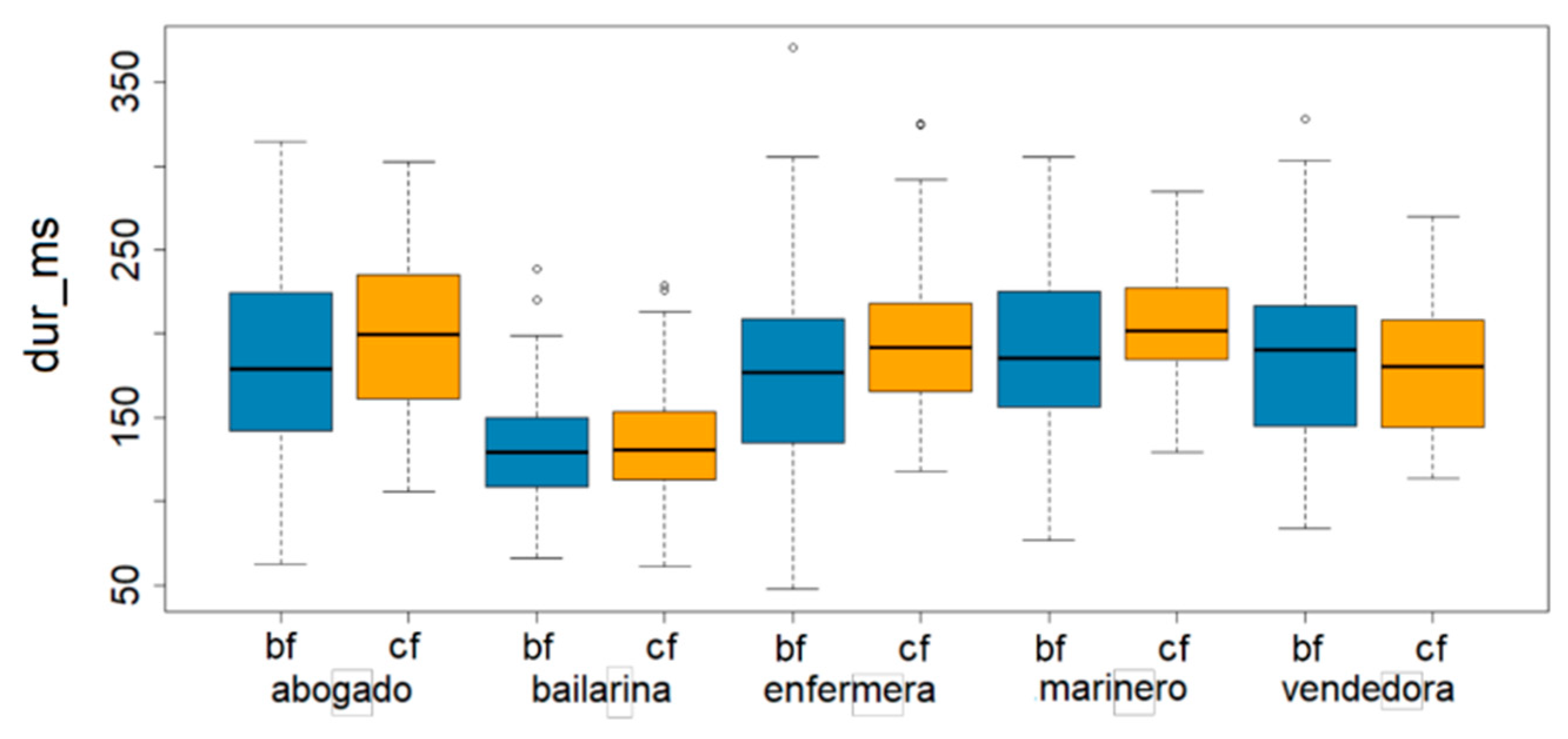
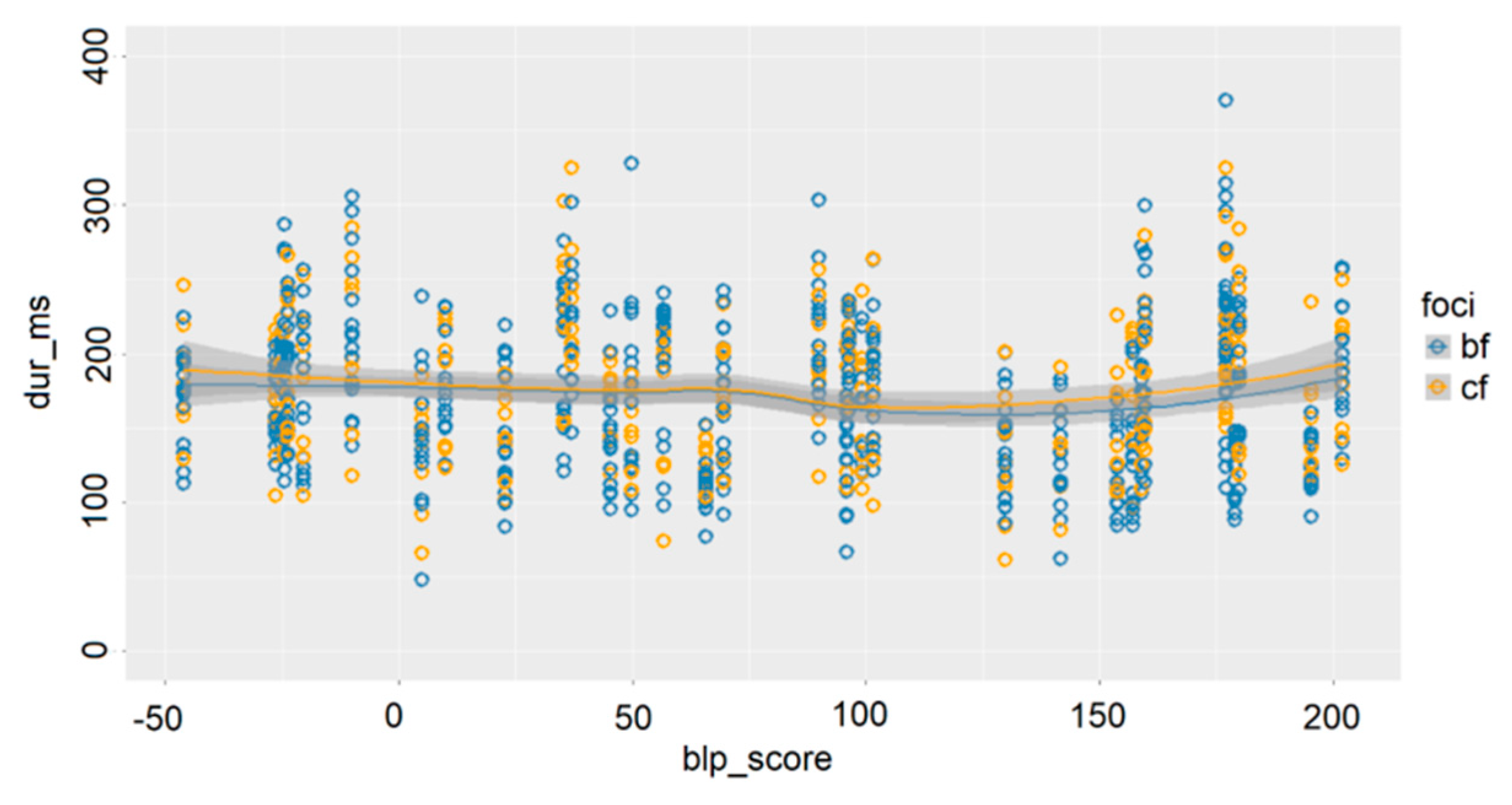
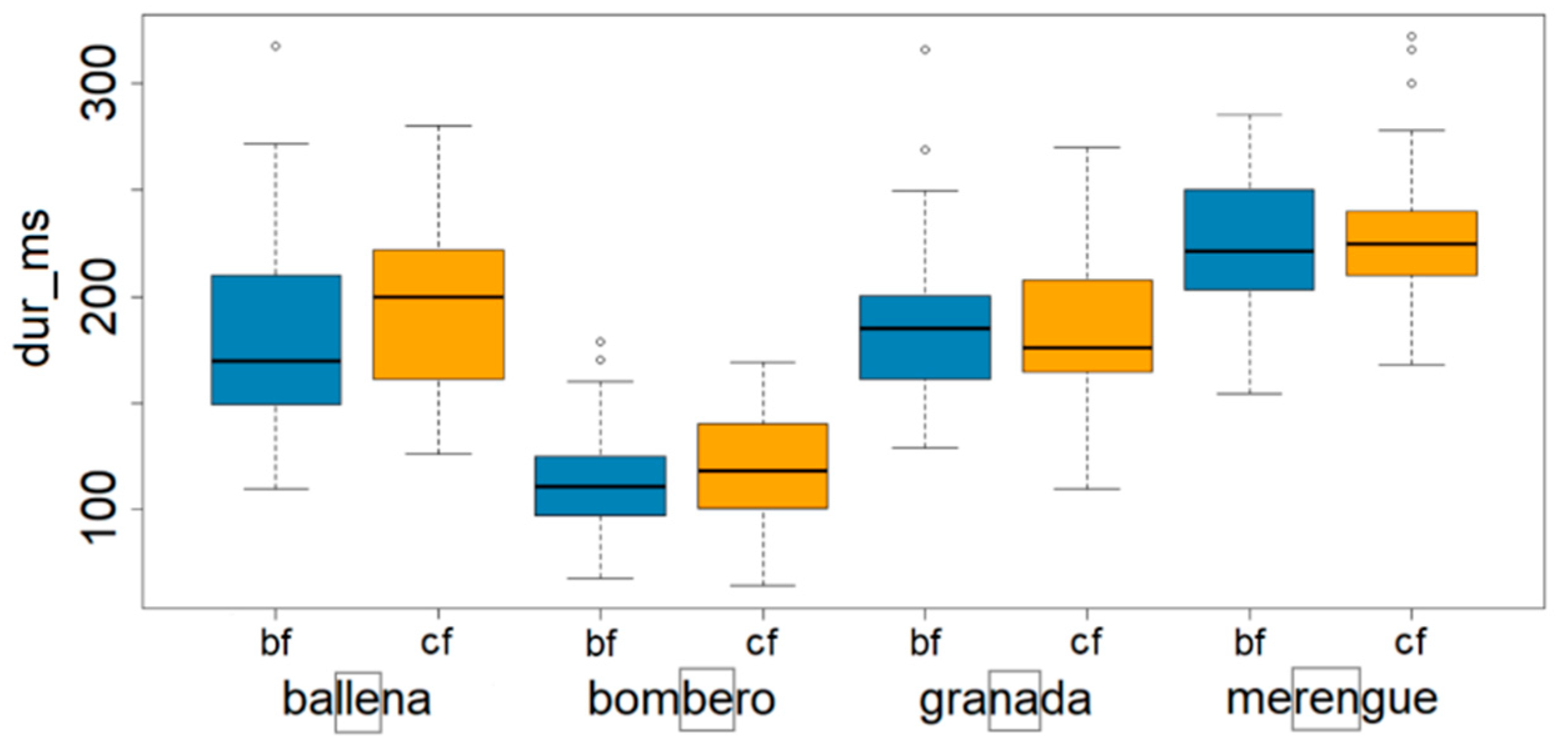
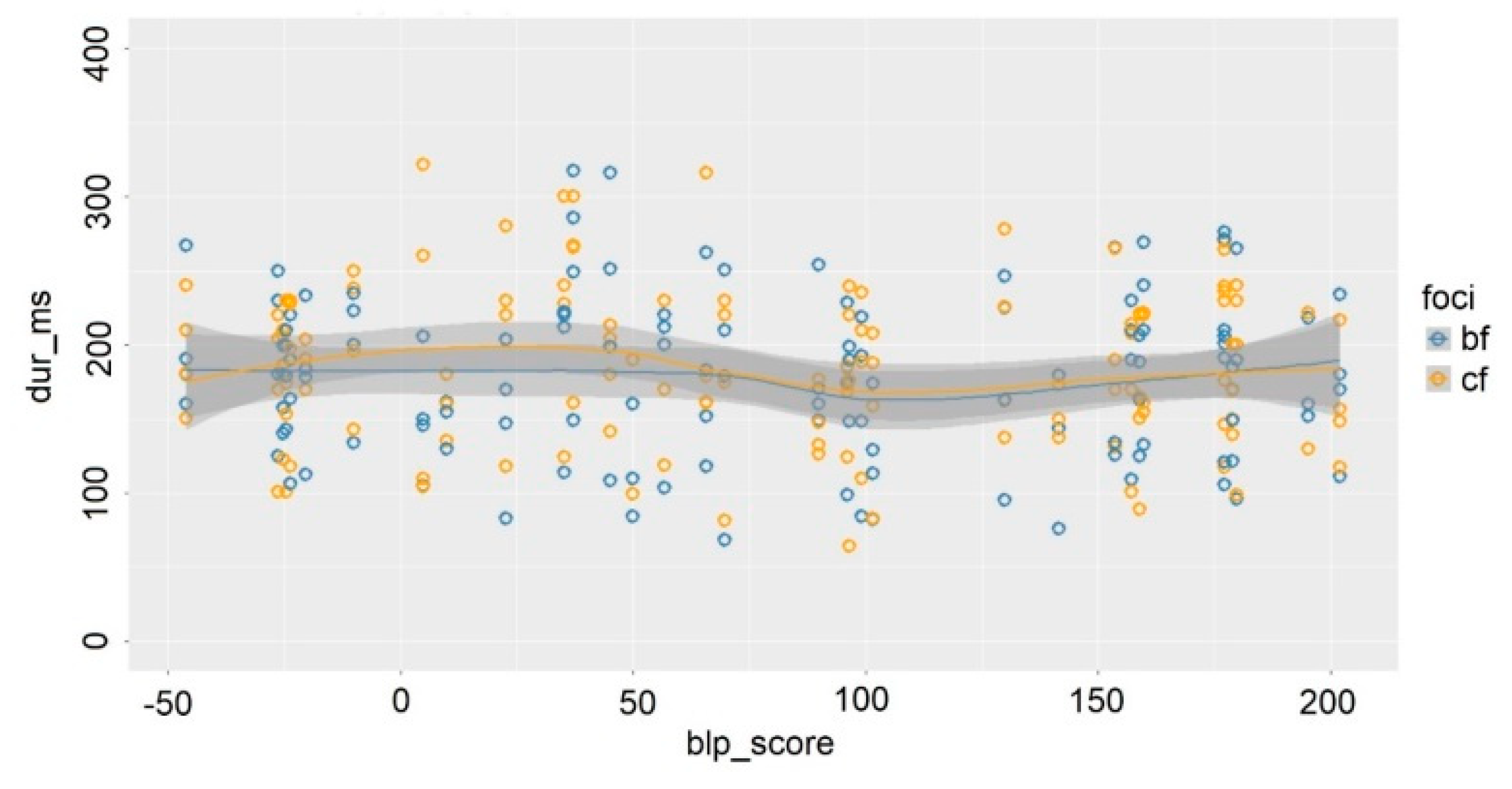
| Short Vowel | Long Vowel |
|---|---|
| chich [t͡ʃit͡ʃ] ‘hard’ | chiich [t͡ʃìːt͡ʃ] ‘granny’ |
| k’an [k’an] ‘yellow’ | k’áan [k’áːn] ‘hammock’ |
| pik [pik] ‘a bug’ | piik [pìːk] ‘petticoat’ |
| Target Syllable | n | Mean (SD) |
|---|---|---|
| abogado | ||
| broad focus | 32 | 182.51 (59.6) |
| contrastive focus | 29 | 195.1 (49.78) |
| bailarina | ||
| broad focus | 129 | 131.82 (30.36) |
| contrastive focus | 89 | 135.54 (33.5) |
| enfermera | ||
| broad focus | 126 | 177.04 (49.25) |
| contrastive focus | 65 | 194.32 (42.9) |
| marinero | ||
| broad focus | 98 | 191.38 (47.6) |
| contrastive focus | 62 | 206.43 (34.32) |
| vendedora | ||
| broad focus | 171 | 182.96 (47.03) |
| contrastive focus | 63 | 179.69 (38.65) |
| Fixed Effect | Estimate | SE | t | p |
|---|---|---|---|---|
| (Intercept) | 154.77 | 18.55 | 8.34 | <0.001 |
| focus | 6.62 | 5.20 | 1.27 | 0.23 (n.s.) |
| BLP score | −0.08 | 0.07 | −1.06 | 0.30 (n.s.) |
| gender | −3.10 | 9.86 | −0.32 | 0.76 (n.s.) |
| age | 0.65 | 0.30 | 2.14 | 0.04 |
| focus BLP score | 0.02 | 0.04 | 0.60 | 0.55 (n.s.) |
| Target Syllable | n | Mean (SD) |
|---|---|---|
| ballena | ||
| broad focus | 32 | 181.52 (44.61) |
| contrastive focus | 33 | 197.36 (37.95) |
| bombero | ||
| broad focus | 31 | 114.22 (26.62) |
| contrastive focus | 31 | 121.12 (25.68) |
| granada | ||
| broad focus | 34 | 190.3 (37.56) |
| contrastive focus | 33 | 185.25 (37.65) |
| merengue | ||
| broad focus | 34 | 222.81 (34.29) |
| contrastive focus | 34 | 228.9 (40.28) |
| Fixed Effect | Estimate | SE | t | p |
|---|---|---|---|---|
| (Intercept) | 174.27 | 25.52 | 6.83 | 0.02 |
| focus | 8.60 | 6.31 | 1.36 | 0.21 (n.s.) |
| BLP score | −0.01 | 0.06 | −0.22 | 0.82 (n.s.) |
| gender | −22.00 | 7.01 | −3.14 | 0.004 |
| age | 0.34 | 0.22 | 1.60 | 0.12 (n.s.) |
| focus BLP score | −0.03 | 0.05 | −0.61 | 0.54 (n.s.) |
© 2019 by the authors. Licensee MDPI, Basel, Switzerland. This article is an open access article distributed under the terms and conditions of the Creative Commons Attribution (CC BY) license (http://creativecommons.org/licenses/by/4.0/).
Share and Cite
García, N.M.; Uth, M. Lack of Syllable Duration as a Post-Lexical Acoustic Cue in Spanish in Contact with Maya. Languages 2019, 4, 84. https://doi.org/10.3390/languages4040084
García NM, Uth M. Lack of Syllable Duration as a Post-Lexical Acoustic Cue in Spanish in Contact with Maya. Languages. 2019; 4(4):84. https://doi.org/10.3390/languages4040084
Chicago/Turabian StyleGarcía, Nuria Martínez, and Melanie Uth. 2019. "Lack of Syllable Duration as a Post-Lexical Acoustic Cue in Spanish in Contact with Maya" Languages 4, no. 4: 84. https://doi.org/10.3390/languages4040084
APA StyleGarcía, N. M., & Uth, M. (2019). Lack of Syllable Duration as a Post-Lexical Acoustic Cue in Spanish in Contact with Maya. Languages, 4(4), 84. https://doi.org/10.3390/languages4040084





